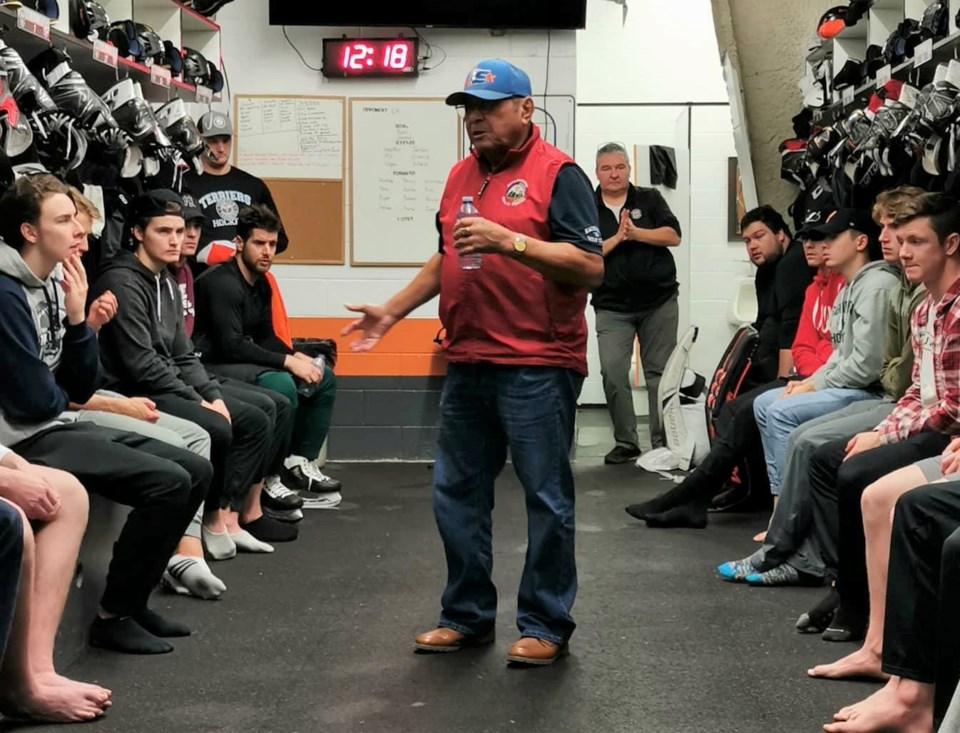Fred Sasakamoose made history as a hockey player more than a half century ago.
Born in 1933 Sasakamoose is a former professional hockey player, which doesn’t make him unique, although it showed he was talented on skates.
But what did make his debut in the National Hockey League historic was that he was the first Canadian indigenousplayer in the NHL, and the first First Nations player with treaty status.
Born on the Ahtahkakoop First Nation, in the Big River, SK. area, Sasakamoose’s road to the NHL was not an easy one, he admitted during an interview with Yorkton This Week Friday. Now 85, he says First Nations players are better situated to succeed than he was.
“First Nations and Metis players play organized hockey now. They communicate more with other (non-aboriginal) players. They’re going to school with them,” he said on a break from activities associated with First Nations Night being hosted by the Painted Hand Casino and Yorkton Junior ‘A' Terriers.
Sasakamoose was only six when taken to live in a residential school.
“There was only Indian kids. We didn’t communicate with white kids,” he said.
So when the Junior hockey team came calling for Sasakamoose to go there to play, it was a massive step into the complete unknown.
“When I went to Moose Jaw in 1948 it changed my life altogether,” he said, then pausing added “for the better.”
But, initially he did not want to go.
“I didn’t think I belonged to white society. That was just my feeling,” he said.
Sasakamoose said he recalls when the hockey scout and local priest arrived at his parent’s door, it had taken the scout four days to find the family in an era when their home still did not have running water or electricity, let alone a telephone.
The scout wanted Sasakamoose in Moose Jaw, an unknown place eight hours south.
“I’d been to Duck Lake 150 miles away. That was a long ways,” he said.
Sasakamoose said he had tears in his eyes, and fear gripping his heart, but his mother said he should go. He told her in two weeks he would be back.
But, Sasakamoose’s skills kept him in Moose Jaw for four years.
“It was a wonderful highlight of my life. I didn’t want to go, but I wanted to play hockey,” he said reflecting on the internal battle he felt.
The first camp in Moose Jaw had 120 players trying out, Sasakamoose the only First Nations player. As cuts began he said he asked why players were no longer in the dressing room. Told they weren’t good enough they had been sent home he asked “why not me? I want to go home.”
In the end he made the team. He said he ended up centering a line with Al Laycock, a black player from Edmonton on his right wing, and Jimmy Chow from Saskatoon, an oriental player on left wing.
“I had a black lace on my right skate for Al Laycock and a yellow lace on my other skate for Jimmy Chow and a red feather on my shoulder for me at centre,” he said.
Finding himself at ease in Moose Jaw Sasakamoose said he began to think.
“You start dreaming. You’re a dreamer and after a couple of years in Junior I got called up in 1952,” he said, adding it was to a camp in Ontario for the National Hockey League’s Chicago Blackhawks.
Sasakamoose would make the Blackhawks for the 1953-54 season, but played only 11 games.
Asked if he looks back and wished he has stuck it out longer, Sasakamoose pauses before replying, “I think so.”
Then he picks up on the short stay in the NHL.
“I had a reason to come home,” he said.
Sasakamoose was married, and at training camp for 21 days had no word from her.
“She didn’t phone or write me a letter. I was getting concerned my wife was going to leave me,” he said, adding he made up his mind to go home.
Now the regrets of hockey are few.
“I had a good life,” he said, adding the marriage to Loretta lasted, resulting in nine children, and today the family of children, grandchildren and great grandchildren number 131.
“Christmas is just like a tornado,” he muses.
Sasakamoose said it feels good too that he is still remembered as a pioneer in terms of hockey.
“There was a barrier that I broke,” he said, although at the time he was not aware of it.
Today, Sasakamoose said players just have more doors open to them.
“It was hard for me to make it. I wasn’t confident in myself. I didn’t think I was good enough,” he said, adding First Nations players today have a greater self believe because others have made it.
And, he wants to see that grow. Sasakamoose said he has meetings planned with Gary Bettman Commissioner of the NHL, and Tom Renney head of Hockey Canada, and the message he wants to get across is that is time a First Nations/Metis team went to the Olympics as a separate hockey team.
“It’s time we are recognized as a nation,” he said.
The Assembly of First Nations, Federation of Saskatchewan Indian Nations (FSIN) and various Saskatchewan First Nations have recognized Sasakamoose for his achievements.
Sasakamoose has been inducted into the Saskatchewan First Nations Sports Hall of Fame, Prince Albert Sports Hall of Fame, Meadow Lake Wall of Fame, FSIN Circle of Honour and the Canadian Native Hockey Hall of Fame. He was installed in the Saskatchewan Sports Hall of Fame in 2007.



